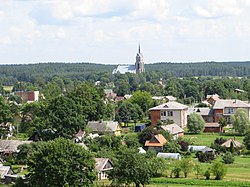History
The settlement of Salakas was first mentioned in written sources in 1496 when a local noble gifted some land with three serfs to the parish church in Salakas and in 1497 when Wojciech Tabor [ pl ], Bishop of Vilnius, gifted some land to a governor of Salakas. [2]
In 1554 the town is mentioned as one of the towns on the main trade route from Vilnius to Riga. Because of this Salakas developed as a trading town. Around 1720, a monastery of the Canons Regular of the Penitence of the Blessed Martyrs was built, a wooden church was attached in 1740. After the failed Uprising of 1831, the monastery was closed by the Tsarist authorities in 1832.
Beginning in the early 19th century, there was a significant Jewish population in Salakas because of its status as a trading town. The percentage of Jewish inhabitants ranged from thirty percent to above fifty percent. At the end of August 1941, about 150 Jews from the town – men, women and children – were murdered during the Holocaust in the nearby forest of Sungardai. [3]
After the Polish–Lithuanian War, the Lithuania–Poland border was located several kilometres from Salakas. This meant that the trade going through the town dried up. [2]
This page is based on this
Wikipedia article Text is available under the
CC BY-SA 4.0 license; additional terms may apply.
Images, videos and audio are available under their respective licenses.



